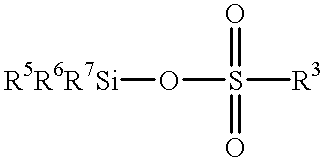Method for manufacturing silicon compound having substituents bonded to silicon atoms via Si-C bonds
a technology of silicon atoms and substituents, which is applied in the direction of group 4/14 element organic compounds, chemical instruments and processes, organic chemistry, etc., can solve the problems of increasing the cost of metals, reducing the selectivity of catalysts, and reducing the activity of catalysts. the better the selectivity, the effect of high catalytic activity and stability
- Summary
- Abstract
- Description
- Claims
- Application Information
AI Technical Summary
Benefits of technology
Problems solved by technology
Method used
Image
Examples
working example 1
Reaction of styrene and 1,1,3,3-tetramethyldisiloxane with a platinum catalyst in the presence of trimethylacetoxysilane and a silyl ester of a sulfonic acid
380 mg Of styrene and 240 mg of 1,1,3,3-tetramethyldisiloxane were placed in a glass tube to which 20 .mu.L (17.6 mg) of trimethylacetoxysilane (Me.sub.3 SiOAc) and 2 .mu.L (2.3 mg) of triisopropylsilyl trifluoromethanesulfonate were added by microsyringe. 5 .mu.L (platinum weight: 0.0017 mg) Of a toluene solution of zero-valent platinum complexed with divinylsiloxane were added to this. The tube was put in a 60.degree. C. oil bath and heated for 8 hours. After cooling, the tube contents were analyzed by gas chromatography, which revealed that the styrene conversion rate was 96%, 1,3-bis(phenethyl)-1,1,3,3-tetramethyldisiloxane had been produced at a yield of 85%, and the ratio of alpha addition to beta addition of phenethyl groups was 1:15.9.
working example 2
Reaction of styrene and 1,1,3,3-tetramethyldisiloxane with a platinum catalyst in the presence of acetic anhydride and a silyl ester of a sulfonic acid
380 mg Of styrene and 240 mg of 1,1,3,3-tetramethyldisiloxane were placed in a glass tube to which 20 .mu.L (21.6 mg) of acetic anhydride and 2 .mu.L (2.3 mg) of triisopropylsilyl trifluoromethanesulfonate (i-Pr.sub.3 SiOSO.sub.2 CF.sub.3) were added by microsyringe. 5 .mu.L (platinum weight: 0.0017 mg) Of a toluene solution (platinum content: 0.04 wt %) of zero-valent platinum complexed with divinylsiloxane were added to this. The tube was put in a 60.degree. C. oil bath and heated for 8 hours. After cooling, the tube contents were analyzed by gas chromatography, which revealed that the styrene conversion rate was 55%, 1-phenethyl-1,1,3,3-tetramethyldisiloxane had been produced at a yield of 58% (based on 1,1,3,3-tetramethyldisiloxane) and 1,3-bis(phenethyl)-1,1,3,3-tetramethyldisiloxane at a yield of 21%, and the ratio of alpha addi...
working example 3
Reaction of allyl chloride and 1,1,3,3-tetramethyldisiloxane with a platinum catalyst in the presence of ethyltriacetoxysilane and a silyl ester of a sulfonic acid
310 mg Of allyl chloride, 405 mg of 1,1,3,3-tetramethyldisiloxane, and 175 mg of toluene were placed in a glass tube to which 10 .mu.L of ethyltriacetoxysilane (EtSi(OAc).sub.3) and 1 .mu.L (1.15 mg) of triisopropylsilyl trifluoromethanesulfonate (i-Pr.sub.3 SiOSO.sub.2 CF.sub.3) were added by microsyringe. 5 .mu.L Of a toluene solution (platinum content: 0.04 wt %) of zero-valent platinum complexed with divinylsiloxane were added to this. The tube was put in an 80.degree. C. oil bath and heated for 18 hours. After cooling, the tube contents were analyzed by gas chromatography, which revealed that 1-(.gamma.-chloropropyl)-1,1,3,3-tetramethyldisiloxane had been produced at a yield of approximately 24%.
PUM
| Property | Measurement | Unit |
|---|---|---|
| temperature | aaaaa | aaaaa |
| temperature | aaaaa | aaaaa |
| temperature | aaaaa | aaaaa |
Abstract
Description
Claims
Application Information
 Login to View More
Login to View More - R&D
- Intellectual Property
- Life Sciences
- Materials
- Tech Scout
- Unparalleled Data Quality
- Higher Quality Content
- 60% Fewer Hallucinations
Browse by: Latest US Patents, China's latest patents, Technical Efficacy Thesaurus, Application Domain, Technology Topic, Popular Technical Reports.
© 2025 PatSnap. All rights reserved.Legal|Privacy policy|Modern Slavery Act Transparency Statement|Sitemap|About US| Contact US: help@patsnap.com


